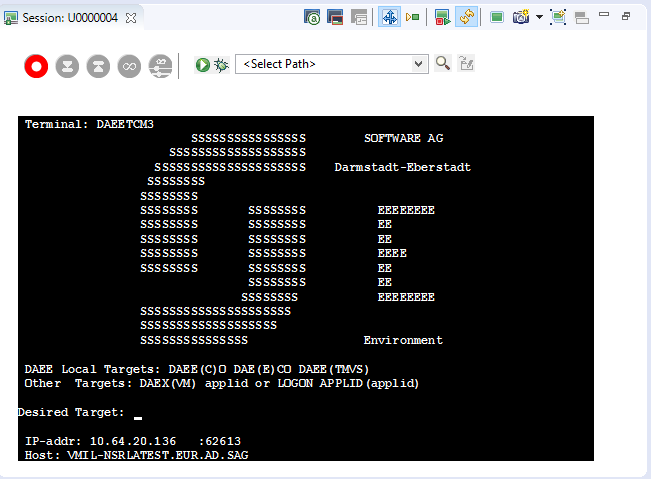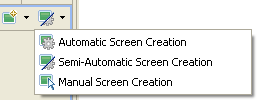The Session View is especially useful when working with screens or test cases, either offline (replay file) or online.

The toolbars are described under Session Properties and Toolbars in the Natural Screen Tester Reference Guide.
The definitions configured here override test project definitions and are relevant for a specific session.
 To create a display session
To create a display session
Open the relevant test project, right-click on the Sessions node and select .
Enter a name and description for the session.
Select the connectivity type:
Use test project configuration: Use the configuration set in the Test Project Properties.
Online: Connect online to the host, and enter the name of the device.
Offline (using trace files): Connect to the session using a trace file. Browse and select the required trace file.
Connection Pool: Select a connection pool from which to take the session.
Click to define the Session General Properties.
Enter the session ID and password.
Select whether or not to create a trace file and where and how it should be saved.
Click .
Duplicating a session will create a new session definition will be created using the same configuration as the original one. Session definitions can be duplicated by right-clicking on the original session and selecting .
Screen Creation Definitions are a set of basic definitions which are used to create a new Natural Screen Tester screen. These definitions include the default screen name, initial identifiers and determine whether input fields will be created. Creating a new screen using screen creation definitions reduces the complexity and the time required to identify new screens.
To use this feature, at least one set of Screen Creation Definitions must be created within a Screen Group (in the dedicated tab). When navigating within a session, and reaching an unidentified screen, Natural Screen Tester searches for Screen Groups which match the unidentified screens, and then creates a new screen based on the screen group's identifiers and on parameters defined in the creation definition configured in the Screen Group. This process can be initiated in three different modes:
Automatically: A screen will automatically be created for each unknown screen that matches a screen group. This screen will include basic screen definitions, which are defined in the screen group.
Semi-automatically: The New Screen Wizard will automatically be displayed for each unknown screen that suits a screen group. This screen will include basic screen definitions, which are defined in the screen group.
Manually: The New Screen Wizard is displayed when clicking on the Identify New Screen icon.
The desired mode is determined by clicking on the Change Screen Definition Mode icon in the Session View.

An unidentified screen can be identified as a screen/screen group by clicking on the New Screen icon in the Session Toolbar. The Create New Screen wizard is displayed. Refer to Creating a New Screen or Creating a New Screen Group for further details.
The screen image of a screen can sometimes change and no longer suit the relevant screen entity. In the Session View there is a Update Screen Image icon, which enables updating the screen image. Click on the arrow next to the icon to view all the relevant screens/screen groups and select the desired one.
A test case can be created either via the Session view or by creating a new test case entity (refer to Creating a Test Project for further details). When creating the test case in the Session, use the test case toolbar to record the test case and then you can edit the test case in the test case dialog box.
 To create a test case from the session
To create a test case from the session
Navigate to the first screen from which you want the recording to commence.
Click on the icon ![]() to display the Test Case Toolbar.
to display the Test Case Toolbar.
Click on the Start recording icon. ![]()
Navigate to the various screens to record the relevant test case.
Click the Mark possible input icon ![]() to mark all the predefined potential input
fields in purple. Click on one of the marked fields you want to include as input for your test case. The field will
be marked orange.
to mark all the predefined potential input
fields in purple. Click on one of the marked fields you want to include as input for your test case. The field will
be marked orange.
Click the Mark possible output icon ![]() to mark all the predefined potential fields in purple.
Click on a field to define it as an assertion for your test case. The field will be marked blue.
to mark all the predefined potential fields in purple.
Click on a field to define it as an assertion for your test case. The field will be marked blue.
If you want to record a step that repeats again and again until a
certain condition is reached, click the Loop icon ![]() , and follow the instructions
in the wizard. This kind of definition can be applicable for collecting data of a host table.
, and follow the instructions
in the wizard. This kind of definition can be applicable for collecting data of a host table.
To end a recording click the Stop recording icon. ![]() Enter a name for the test case.
Enter a name for the test case.
Click Finish. The editor will open where you can manually edit and add nodes.
A test case can be run/debugged in the session viewer, by selecting
a test case from the list and then clicking on the run/debug icon. ![]()
When running a test case, you will be required to insert inputs as necessary.
When debugging a test case, the Debug perspective will open.
The screen navigation defined in the Test Project Map can be tested to ensure that the navigation behavior is as expected. This is done in the Session View, using the Test Project Map toolbar. The toolbar enables selecting a screen to which you expect to be able to navigate to from the current screen and then attempting to navigate to this screen. If the Test Project Map is correctly defined, then Natural Screen Tester will successfully navigate to the selected screen. If the Test Project Map does not have the relevant steps defined to reach the screen you selected or if these steps are not "Approved" steps, a pop-up message will inform you of this.
Note:
The Test Project Map toolbar is not available when working offline.
See Test Project Toolbar.
Within a session, you can navigate online, interacting directly with the host, or to replay a previously recorded navigation session. When working directly with the host, you can create a trace file that records the navigation between the screens. This can later be used and replayed, enabling you to work offline (in replay mode).
Online session navigation using the session view is similar to regular host navigation:
Use the keyboard to enter any alphanumerical input.
Use the Enter key to send Enter to the host.
Use the function keys (F1-F12) or the PF buttons toolbar to send corresponding PF1-PF12 keys to the host.
Use the SHIFT key combined with the function keys to send PF13-PF-24 keys to the host (Shift+PF1=PF13, Shift+PF2=PF14 and so on).
Use the Customize Host Keys to define and send any other host key.
When working online, you can use the Trace file feature to record a file, and trace the connection communication (connection pool or user) between the Natural Screen Tester server and the host, for each connection. Details for setting the default trace file parameters can be found in Recording Trace Files. You can override the test project settings and define settings per session either when creating a new session connection or in the session properties of an existing session.
In order to debug or reconstruct specific scenarios, you can replay (GCT) files that have traced the steps of these scenarios. In order to replay such files, the test project configuration definitions must indicate that instead of working online with the host, Natural Screen Tester must, when connecting, access and replay the specific file. The default trace file used is defined in the Test Project Properties dialog box (refer to Working with Offline Sessions for further details). To override these settings, define the relevant settings per session either when creating a new session connection or in the session properties of an existing session.
When replaying a file, you may want to navigate to a specific screen. The replay navigator enables this, simply and efficiently, using the Replay Navigator slider. Note: In the replay mode, any function keystroke (such as [ENTER], PF keys etc.) displays the following screen, according to the screen order in the recorded GCT file, therefore, key selection is meaningless. This feature is not available when connecting to a host connection pool (online or offline).
When connecting to a session which has been defined as working offline, in replay mode, (refer to Working with Offline Sessions for further details) the Replay Navigator slider is displayed.

This toolbar is displayed by default and can be hidden by clicking on the toolbar icon.
To navigate to the different screens either drag the slider's indicator along until reaching the relevant screen number (the screen number is indicated by a ToolTip), or enter the number in the box to the right of the slider and click the Go arrow or select a screen from the list and click the Go arrow. The slider indicator as well as the number in the box on the right will change according to the present screen number.
You can search for screens associated with a specific screen group, by selecting the screen group from the list of screens/screen groups. Clicking on will search for the first screen encountered, which is associated with the selected screen group. Clicking additional times will search for additional screens associated with this screen group.
Click on the Show user input icon (the last button) to display the input that the user entered while the GCT was recorded (when the button is not clicked the screen is displayed as it was before the changes were made). When the button is clicked, the contents of the input fields that were changed appear in red, a string representation of the host key sent appears in the toolbar and the cursor is positioned in the position it was in when the screen was sent to the host.
Note:
When replaying a file that has a Connection Pool, the Replay
Navigator slider is not available for the Natural UNIX protocol.
Select the destination screen from the drop down list of screens, then click on the Navigate to screen icon. See Test Project Map Toolbar.
Note:
The Test Project Map toolbar is not displayed when working offline.
Switch between these modes by changing the connection type in the Session Properties, or by editing the file _inc_applconf.asp.
When there is a window within a screen, you can define that
the screen area outside the window will be grayed out or displayed in regular
colors. This is done by clicking on the Window icon on the session toolbar
![]() .
.
Note that it is not possible to navigate outside the window.